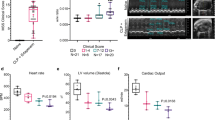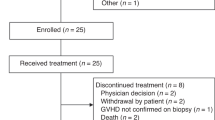Abstract
The toxicity due to interleukin-2 (IL-2) strongly resembles the clinical picture seen during septic shock. In septic shock activation of polymorphonuclear neutrophils (PMN) and the complement system contribute significantly to the pathophysiology of the condition. We therefore investigated whether similar events contributed to the toxicity observed with IL-2. Four patients received seven cycles of escalating dose IL-2 (18.0 to 72.0 X 10(6) IU m-2 day-1) and 16 were treated with 20 cycles of fixed dose IL-2 (12.0 or 18.0 X 10(6) IU m-2 day-1). Toxicity, as judged by hypotension (P = less than 0.005) and capillary leakage (fall in serum albumin 18.2 vs 4.0 gm l-1; P = less than 0.0005 and weight gain 4.0 vs 1.2 kg; P = less than 0.025) were worse with the esc. dose protocol. PMN became activated following IL-2 with mean peak elastase/alpha 1-antitrypsin (E alpha 1 A) and lactoferrin values of 212 (SEM = 37) and 534 (SEM = 92) ng ml-1 respectively occurring 6 h after the IL-2. Peak values for the esc. dose IL-2 group being generally higher than 500 ng ml-1. Activation of the complement cascade was evidenced by a dose dependent elevation of peak C3a values (fixed dose 9.1 (SEM = 0.6); esc. dose 25.7 (SEM = 6.33); P = less than 0.005) on day 5 of IL-2. There was a significant correlation between C3a levels and the degree of hypotention during the first 24 h after IL-2 (r = 0.91) and parameters of capillary leakage such as weight gain and fall in serum albumin (r = 0.71). These data suggest that activation of PMN initiates endothelial cell damage which subsequently leads to activation of the complement cascade. This latter system then contributes to the haemodynamic changes and capillary leakage seen in IL-2 treated patients.
This is a preview of subscription content, access via your institution
Access options
Subscribe to this journal
Receive 24 print issues and online access
$259.00 per year
only $10.79 per issue
Buy this article
- Purchase on Springer Link
- Instant access to full article PDF
Prices may be subject to local taxes which are calculated during checkout
Similar content being viewed by others
Author information
Authors and Affiliations
Rights and permissions
About this article
Cite this article
Baars, J., Hack, C., Wagstaff, J. et al. The activation of polymorphonuclear neutrophils and the complement system during immunotherapy with recombinant Interleukin-2. Br J Cancer 65, 96–101 (1992). https://doi.org/10.1038/bjc.1992.18
Issue Date:
DOI: https://doi.org/10.1038/bjc.1992.18
This article is cited by
-
Intravenous ascorbic acid as an adjuvant to interleukin-2 immunotherapy
Journal of Translational Medicine (2014)
-
Levels of the terminal complement complex, C3a-desArg and C1-inhibitor in adult patients with capillary leak syndrome following bone marrow transplantation
Annals of Hematology (1995)
-
Therapy with interleukin-2 induces the systemic release of phospholipase-A2
Cancer Immunology, Immunotherapy (1995)
-
Monitoring of immunotherapy with cytokines or monoclonal antibodies
Cytotechnology (1995)
-
The immunobiological effects of interleukin-2 in vivo
Cancer Immunology, Immunotherapy (1994)



